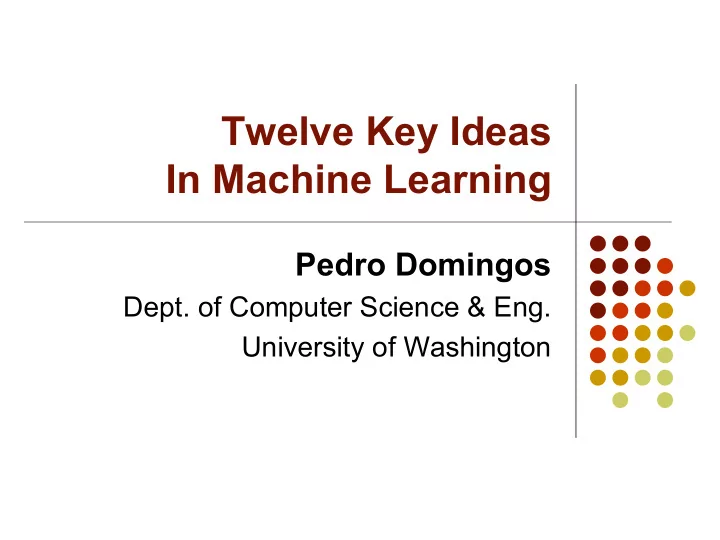

Twelve Key Ideas In Machine Learning Pedro Domingos Dept. of Computer Science & Eng. University of Washington
Traditional Programming Data Output Computer Program Machine Learning Data Program Computer Output
Example: Classification l Classifier l Input: Vector of discrete/numeric values (features) l Output: Class l Example: Spam filter l Learner l Input: Training set of (input, output) examples l Output: Classifier l Test: Predictions on new examples
1. Learning = Representation + Evaluation + Optimization l Thousands of learning algorithms l Combinations of just three elements Representation Evaluation Optimization Instances Accuracy Greedy search Hyperplanes Precision/Recall Branch & bound Decision trees Squared error Gradient descent Sets of rules Likelihood Quasi-Newton Neural networks Posterior prob. Linear progr. Graphical models Margin Quadratic progr. Etc. Etc. Etc.
2. It ’ s Generalization that Counts l Test examples never seen before l Training examples can just be memorized l Set data aside to test l Don ’ t tune parameters on test data l Use cross-validation l No access to optimization goal l Local optimum may be fine
3. Data Alone Is Not Enough l Classes of unseen examples are arbitrary l So learner must make assumptions l “ No free lunch ” theorems l Luckily, real world is not random l Induction is knowledge lever
4. Overfitting Has Many Faces l Overfitting = Hallucinating patterns = Chosen classifier not best on test l The biggest problem in machine learning l Bias and variance l Less powerful learners can be better l Solutions l Cross-validation l Regularization
5. Intuition Fails In High Dimensions l Curse of dimensionality l Sparseness worsens exponentially with number of features l Irrelevant features ruin similarity l In high dimensions all examples look alike l 3D intuitions do not apply in high dimensions l Blessing of non-uniformity
6. Theoretical Guarantees Are Not What They Seem l Bounds on number of examples needed to ensure good generalization l Extremely loose l Low training error ≠ > Low test error l Asymptotic guarantees may be misleading l Theory is useful for algorithm design, not evaluation
7. Feature Engineering Is the Key l Most effort in ML projects is constructing features l Black art: Intuition, creativity required l ML is iterative process
8. More Data Beats A Cleverer Algorithm l Easiest way to improve: More data l Then: Data is bottleneck l Now: Scalability is bottleneck l ML algorithms more similar than they appear l Clever algorithms require more effort but can pay off in the end l Biggest bottleneck is human time
9. Learn Many Models, Not Just One l Three stages of machine learning Try variations of one algorithm, chose one 1. Try variations of many algorithms, choose one 2. Combine many algorithms, variations 3. l Ensemble techniques l Bagging l Boosting l Stacking l Etc.
10. Simplicity Does Not Imply Accuracy l Occam ’ s razor l Common misconception: Simpler classifiers are more accurate l Contradicts “ no free lunch ” theorems l Counterexamples: ensembles, SVMs, etc. l Can make preferred hypotheses shorter
11. Representable Does Not Imply Learnable l Standard claim: “ My language can represent/approximate any function ” l No excuse for ignoring others l Causes of non-learnability l Not enough data l Not enough components l Not enough search l Some representations exponentially more compact than others
12. Correlation Does Not Imply Causation l Predictive models are guides to action l Often interpreted causally l Observational vs. experimental data l Correlation → Further investigation
To Learn More l Article: P. Domingos, “ A Few Useful Things to Know About Machine Learning, ” Communications of the ACM , October 2012 (Free version on my Web page) l Online course: https://www.coursera.org/course/machlearning
Recommend
More recommend